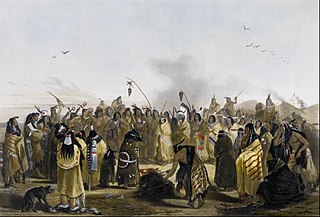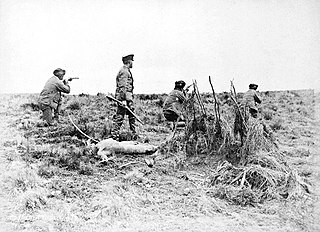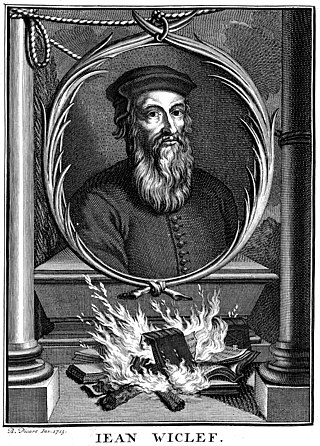Related Research Articles
Catharism was a Christian quasi-dualist or pseudo-Gnostic movement which thrived in Southern Europe, particularly in northern Italy and southern France, between the 12th and 14th centuries. Denounced as a heretical sect by the Catholic Church, its followers were attacked first by the Albigensian Crusade and later by the Medieval Inquisition, which eradicated the sect by 1350. Many thousands were slaughtered, hanged, or burnt at the stake, sometimes without regard for "age or sex."

The Albigensian Crusade or Cathar Crusade (1209–1229) was a military and ideological campaign initiated by Pope Innocent III to eliminate Catharism in Languedoc, what is now southern France. The Crusade was prosecuted primarily by the French crown and promptly took on a political aspect. It resulted in the significant reduction of practicing Cathars and a realignment of the County of Toulouse with the French crown. The distinct regional culture of Languedoc was also diminished.

The Waldensians, also known as Waldenses, Vallenses, Valdesi, or Vaudois, are adherents of a church tradition that began as an ascetic movement within Western Christianity before the Reformation. Originally known as the Poor of Lyon in the late twelfth century, the movement spread to the Cottian Alps in what is today France and Italy. The founding of the Waldensians is attributed to Peter Waldo, a wealthy merchant who gave away his property around 1173, preaching apostolic poverty as the way to perfection.

"The Most Dangerous Game", also published as "The Hounds of Zaroff", is a short story by Richard Connell, first published in Collier's on January 19, 1924, with illustrations by Wilmot Emerton Heitland. The story features a big-game hunter from New York City who falls from a yacht and swims to what seems to be an abandoned and isolated island in the Caribbean, where he is hunted by a Russian aristocrat. The story is inspired by the big-game hunting safaris in Africa and South America that were particularly fashionable among wealthy Americans in the 1920s.

Scalping is the act of cutting or tearing a part of the human scalp, with hair attached, from the head, and generally occurred in warfare with the scalp being a trophy. Scalp-taking is considered part of the broader cultural practice of the taking and display of human body parts as trophies, and may have developed as an alternative to the taking of human heads, for scalps were easier to take, transport, and preserve for subsequent display. Scalping independently developed in various cultures in both the Old and New Worlds.

The Selk'nam, also known as the Onawo or Ona people, are an indigenous people in the Patagonian region of southern Argentina and Chile, including the Tierra del Fuego islands. They were one of the last native groups in South America to be encountered by migrant Europeans in the late 19th century. In the mid-19th century, there were about 4,000 Selk'nam; in 1916 Charles W. Furlong estimated there were about 800 Selk'nam living in Tierra del Fuego; with Walter Gardini stating that by 1919 there were 279, and by 1930 just over 100.

Wolf hunting is the practice of hunting wolves. Wolves are mainly hunted for sport, for their skins, to protect livestock and, in some rare cases, to protect humans. Wolves have been actively hunted since 8,000 to 10,000 years ago, when they first began to pose a threat to livestock of Neolithic human communities. Historically, the hunting of wolves was a huge capital- and manpower-intensive operation. The threat wolves posed to both livestock and people was considered significant enough to warrant the conscription of whole villages under threat of punishment, despite the disruption of economic activities and reduced taxes. The hunting of gray wolves, while originally actively endorsed in many countries, has become a controversial issue across the globe. Most people see it as cruel, unnecessary and based on misconceptions, while proponents argue that it is vital for the conservation of game herds and as pest control.
In paleoanthropology, the hunting hypothesis is the hypothesis that human evolution was primarily influenced by the activity of hunting for relatively large and fast animals, and that the activity of hunting distinguished human ancestors from other hominins.

Dawson Island is an island in the Strait of Magellan that forms part of the Tierra del Fuego archipelago, 100 km south of the city of Punta Arenas in Chile, and part of the Municipality of Punta Arenas. It is located southeast of Brunswick Peninsula. It is often lashed with harsh Antarctic weather. The settlements are Puerto Harris, Puerto San Antonio and Puerto Almeida.

Fuegians are the indigenous inhabitants of Tierra del Fuego, at the southern tip of South America. The name has been credited to Captain James Weddell, who supposedly created the term in 1822.

The Most Dangerous Game is a 1932 American pre-Code horror film, directed by Ernest B. Schoedsack and Irving Pichel, starring Joel McCrea, Fay Wray and Leslie Banks.

Hunting in Russia has an old tradition in terms of indigenous people, while the original features of state and princely economy were farming and cattle-breeding. There was hunting for food as well as sport. The word "hunting" first appeared in the common Russian language at the end of the 15th century. Before that the word "catchings" existed to designate the hunting business in general. The hunting grounds were called in turn lovishcha ("ловища"). In the 15th-16th centuries, foreign ambassadors were frequently invited to hunts; they also received some of the prey afterwards.

The Selk'nam genocide was the systematic extermination of the Selk'nam people, one of the four indigenous peoples of Tierra del Fuego, in the late 19th and early 20th centuries. Historians estimate that the genocide spanned a period of between ten and twenty years, and resulted in the decline of the Selk'nam population from approximately 4,000 people during the 1880s to a few hundred by the early 1900s.

The Apache–Mexico Wars, or the Mexican Apache Wars, refer to the conflicts between Spanish or Mexican forces and the Apache peoples. The wars began in the 1600s with the arrival of Spanish colonists in present-day New Mexico. War between the Mexicans and the Apache was especially intense from 1831 into the 1850s. Thereafter, Mexican operations against the Apache coincided with the Apache Wars of the United States, such as during the Victorio Campaign. Mexico continued to operate against hostile Apache bands as late as 1915.

The Fuegian dog, or Yahgan dog, or Patagonian dog, is an extinct type of canid. In comparison to the domestic dog's ancient wolf ancestry, the Fuegian dog was traditionally thought to be bred and domesticated from the South American culpeo, also known as the culpeo fox. However, 2023 research suggested that the traditional accounts of the Fuegian dog were in fact two different animals. The culpeo itself is similar to true foxes, though it is closer, genetically, to wolves, coyotes and jackals ; thus it is placed in a separate genus within the South American foxes or zorros.

Mow-way or Moway also referred to by European settlers as Shaking Hand or Hand Shaker, was the principal leader and war chief of the Kotsoteka band of the Comanche during the 1860s and 1870s, following the deaths of Kuhtsu-tiesuat in 1864 and Tasacowadi in 1872.

Proto-Protestantism, also called pre-Protestantism, refers to individuals and movements that propagated various ideas later associated with Protestantism before 1517, which historians usually regard as the starting year for the Reformation era. The relationship between medieval sects and Protestantism is an issue that has been debated by historians.

"The Most Dangerous Game" is a highly influential 1924 short story by Richard Connell. It tells the story of big-game hunter Sanger Rainsford becoming the hunted when trapped on a jungle island owned by General Zaroff, a Russian aristocrat who has turned to hunting man after growing bored of hunting animals. This story has been adapted into many works across many forms of media, including film, radio, television, and others.
References
- ↑ For example: Hochschild, Adam (2016). Spain in Our Hearts. New York: Houghton Mifflin Harcourt. pp. 37. ISBN 978-0547973180.
'Sons of landowners,' writes the historian Antony Beevor, 'organized peasant hunts on horseback. [...]'
- ↑ Tice, Paul (2003) [1829]. History of the Waldenses: From the Earliest Period to the Present Time (reprint ed.). San Diego, California: The Book Tree. p. xii. ISBN 978-1585090990 . Retrieved 21 November 2022.
In 1233 the Inquisition was officially unleashed on the Waldenses, and the assault continued for centuries. [...] the Church hunted Waldensians as a group and individually.
- ↑ Barber, Malcolm (17 June 2014) [2000]. The Cathars: Dualist Heretics in Languedoc in the High Middle Ages. The Medieval World. Abingdon: Routledge. ISBN 978-1317890386 . Retrieved 21 November 2022.
If the Cathars could be deprived of their customary refuges, they would be vulnerable to an active policy of heresy hunting. 'We will purge', promised Count Raymond,'these lands of heretics and of the stench of heresy [...].'
- ↑ Van Amberg, Joel (2011). A Real Presence: Religious and Social Dynamics of the Eucharistic Conflicts in Early Modern Augsburg 1520–1530. Studies in the History of Christian Traditions, Volume 158. Leiden: Brill. p. 188. ISBN 978-9004217393 . Retrieved 21 November 2022.
- ↑ Beard, Augustus F. (1884). "Churches of the Huguenots and the religious condition of France". In Smyth, Egbert Coffin (ed.). The Andover review. Vol. 1. Newton, Massachusetts: Andover Theological Seminary. p. 64. Retrieved 21 November 2022.
The army, as if led by the Furies, was employed for years in hunting Huguenots. The history reads as if diabolism were let loose.
- ↑ MacLaughlin, Jim (2008). ""The Gypsy as 'other'in European society: Towards a political geography of hate". The European Legacy. 4 (3): 35–49. doi:10.1080/10848779908579970.
- 1 2 Hochschild, Adam (2016). Spain in Our Hearts. New York: Houghton Mifflin Harcourt. pp. 37. ISBN 978-0547973180.
- ↑ Beevor, Antony (2006). The Battle for Spain: The Spanish Civil War, 1936–1939 . Penguin. p. 77. ISBN 978-0143037651.
This sort of activity was jokingly referred to as the 'reforma agraria' whereby the landless bracero was finally to get a piece of ground for himself.
- ↑ Mendoza, Abraham O. (2011). "War and Diplomacy: Introduction: Conflict and Aggression in Early Human Societies". In Andrea, Alfred J.; Neel, Carolyn (eds.). World History Encyclopedia. Vol. 10. Santa Barbara, California: ABC-CLIO. pp. 256–257. ISBN 9781-851099290 . Retrieved 21 November 2022.
Scholars who subscribe to sociobiological explanations for violence and conflict in early human societies [...] argue that biological drives predetermine human behavior. Though initially displaying such behaviors when hunting game and developing tools for such activities, hunter-gatherers eventually used their developing aggressive techniques against each other [...].
- ↑ Otterbein, Keith F. (24 March 2009). "The Evolution of War". The Anthropology of War. Long Grove, Illinois: Waveland Press. p. 65. ISBN 978-1478609889 . Retrieved 21 November 2022.
Warfare developed along two separate paths. The hunting of large game animals was critical to the development of the first path. Early hunters, working as a group in pursuit of game, sometimes engaged in attacks on members of competing groups of hunters [...].
- ↑ Wright, Daniel (April–May 2016). "Hunting humans: A future for tourism in 2200". Futures . 78–79: 34–46. doi:10.1016/j.futures.2016.03.021.
- ↑ Dixon, Wheeler Winston (2010). A History of Horror. Rutgers University Press. p. 42. ISBN 978-0813550398.